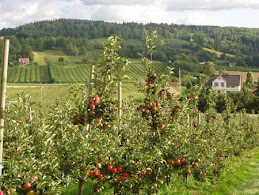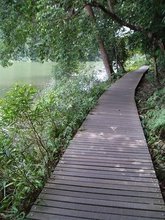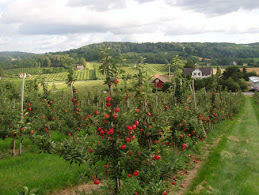From http://epaper.mypaper.sg/emnd/fvxen/fvxp/fvxpress.php?param=2014-04-18
Source Website: http://mypaper.sg/lifestyle/undo-ageing-skin-exercise-20140418
By mypaper, NYT, Published on Apr 18, 2014

PHOTO: SECRET OF YOUTH: Taking up regular exercise, even late in life, could well keep you looking as young as someone half your age.
FILE PHOTO: THE STRAITS TIMES
https://blogger.googleusercontent.com/img/b/R29vZ2xl/AVvXsEioBlIeYWI4XvbRejPFhWhufq6r3q7_Vb80Ik0-ntO5mhmYn5Ihmc5WZ7jG7-pQ_GrDEddghXRaLe6OF_hDJNcTbQdWwJ8F67g6B5lkocBySWZKhnaMLkxqwtQR1bvlnqVc9BMyikZuNTk/s1600/Undo+ageing+skin+with+exercise.jpg
My Paper, Friday, April 18, 2014, Page A12, Lifestyle
NEW YORK
EXERCISE seems to keep skin younger - and it might even reverse skin ageing in people who start exercising late in life, according to startling new research.
The skin alters as the years go by, resulting in wrinkles, crow's feet and sagging patches. These transformations occur because of changes within the layers of the skin, not because of damage from the sun. Time is the chief culprit.
Recently, researchers at McMaster University in Ontario, Canada, began to wonder if such changes were inevitable. Earlier studies there involving mice bred to age prematurely had shown that a steady regimen of exercise could stave off or even undo signs of early ageing in the animals.
Humans swopped fur for bare skin long ago, but if exercise could keep the outer layer of the mice from changing with age, it might, the researchers speculated, do the same for human skin.
To test the possibility, they gathered 29 male and female volunteers aged 20 to 84. About half of the participants were active (at least three hours of moderate or vigorous physical activity a week), while the others were resolutely sedentary (less than an hour of exercise a week). The researchers then asked each volunteer to uncover a buttock.
"We wanted to examine skin that had not been frequently exposed to the sun," said Dr Mark Tarnopolsky, a professor of paediatrics and exercise science at McMaster who oversaw the study, which was presented this month at the American Medical Society for Sports Medicine's annual meeting in New Orleans.
The scientists biopsied skin samples from each volunteer and examined them microscopically.
When compared strictly by age, the samples overall aligned with what would be expected. Older volunteers generally had thicker outer layers of skin and significantly thinner inner layers.
However, the results differed noticeably when the samples were further subdivided by exercise habits.
Among those older than 40, the participants who exercised frequently had a markedly thinner and healthier stratum corneum - the outermost layer of the epidermis, which makes up the top few tiers of the skin.
Beneath the epidermis, the layers of dermis were thicker as well.
In terms of skin composition, these participants - even those past the age of 65 - had more in common with the 20- to 30-year-olds than with others of their own age.
Nevertheless, other factors such as diet, genes or lifestyle might have led to the differences in skin condition between the active and sedentary groups. It was impossible to tell whether exercise by itself had affected the skin or whether genetics and healthy lives had been responsible.
Thus, the researchers devised a further test, for which sedentary volunteers were put through an exercise programme. The participants were 65 or older and, from the samples obtained beforehand, had normal skin for their age at the start of the study.
They began a fairly straightforward endurance training programme, working out twice a week by jogging or cycling at a moderately strenuous pace - equivalent to at least 65 per cent of their maximum aerobic capacity for 30 minutes.
The programme lasted three months, after which the researchers again biopsied the volunteers' skin.
The samples looked quite different, with outer and inner layers that appeared very similar to those of 20- to 40-year-olds.
"I don't want to over-hype the results, but it was pretty remarkable," said Dr Tarnopolsky, himself a middle-aged exerciser.
Under a microscope, the volunteers' skin "looked like that of a much younger person, and all they had done differently was exercise".
By mypaper, NYT, Published on Apr 18, 2014
 PHOTO: Matured nude ad for dove
PHOTO: Matured nude ad for doveEXERCISE seems to keep skin younger.
Posted by Anna Adrielle on Sep 03, 2013, 01:37 am
https://blogger.googleusercontent.com/img/b/R29vZ2xl/AVvXsEg8pZHTiKkAfjrO0vHE-0ni8ZSNlpHlShOxz8IHvZ0rmhQSAt9S64hik0EjlGlN50t3LeOeucQ6i6mHyLpVSb-FM-a7jcrg7RefZf2HjLZ6yv-y2pAYIFCJpUHOO_fg3D8KH11VEKg66es/s1600/blog+dove+wendy-1.png
http://www.businessweek.com/the_thread/brandnewday/archives/blog%20dove%20wendy.png
http://www.modelmayhem.com/po.php?thread_id=901969
Reference
- My Paper, Friday, April 18, 2014, Page A12, Lifestyle
- http://epaper.mypaper.sg/emnd/fvxen/fvxp/fvxpress.php?param=2014-04-18
- http://mypaper.sg/lifestyle/undo-ageing-skin-exercise-20140418
- https://blogger.googleusercontent.com/img/b/R29vZ2xl/AVvXsEioBlIeYWI4XvbRejPFhWhufq6r3q7_Vb80Ik0-ntO5mhmYn5Ihmc5WZ7jG7-pQ_GrDEddghXRaLe6OF_hDJNcTbQdWwJ8F67g6B5lkocBySWZKhnaMLkxqwtQR1bvlnqVc9BMyikZuNTk/s1600/Undo+ageing+skin+with+exercise.jpg
- My Paper, Friday, April 18, 2014, Page A12, Lifestyle
- https://blogger.googleusercontent.com/img/b/R29vZ2xl/AVvXsEg8pZHTiKkAfjrO0vHE-0ni8ZSNlpHlShOxz8IHvZ0rmhQSAt9S64hik0EjlGlN50t3LeOeucQ6i6mHyLpVSb-FM-a7jcrg7RefZf2HjLZ6yv-y2pAYIFCJpUHOO_fg3D8KH11VEKg66es/s1600/blog+dove+wendy-1.png
- http://www.businessweek.com/the_thread/brandnewday/archives/blog%20dove%20wendy.png
- http://www.modelmayhem.com/po.php?thread_id=901969









































.jpg)
.gif)
.jpg)
















































%20-%20%E5%82%B7%E5%BF%83%E7%9A%84%E8%B7%AF%20(Sh%C4%81ng%20x%C4%ABn%20de%20l%C3%B9)%20-%20The%20Road%20of%20Sorrow%20(With%20Subtitle)_11.png)







